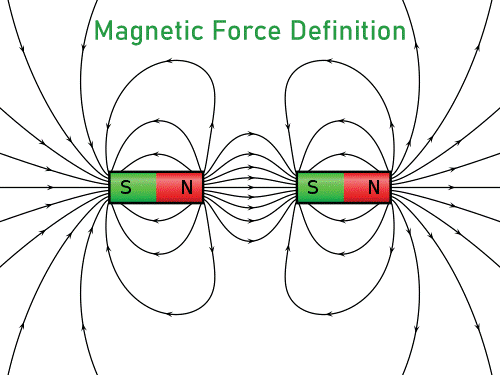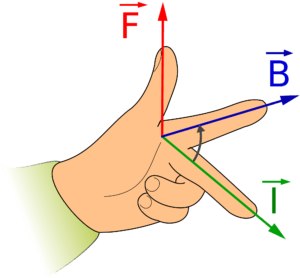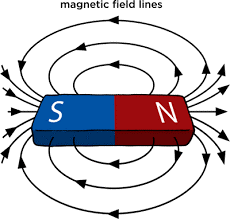Magnetic Force DefinitionIntroductionThe concept of magnetic force has existed for centuries, yet it remains one of nature's most mysterious and fascinating forces. This article will provide an overview of the concept of magnetic force, including its properties, applications, and history. 
DefinitionMagnetic force is a physical phenomenon that occurs when a magnetic field interacts with an electric current or a permanent magnet. The force generated by the magnetic field attracts or repels other magnetic objects. The force's magnitude depends on the strength of the magnetic field and the distance between the two objects. Magnetic force is an invisible, intangible force between two objects with a magnetic field. It can be attractive or repulsive, depending on the orientation of the magnetic fields. The force is caused by the exchange of virtual particles known as photons, which are exchanged between objects. The magnitude of the force is determined by the strength of the magnetic fields and the distance between the objects. History of Magnetic ForceThe concept of magnetic force has been around since ancient times. In ancient Greece, the philosopher Thales of Miletus was the first to recognize the attraction and repulsion between magnets. In the 16th century, William Gilbert was the first to propose that the Earth was a giant magnet. In the 19th century, Michael Faraday and James Clerk Maxwell developed the mathematical equations that describe the behaviour of magnetic fields. Properties of Magnetic ForceThe properties of magnetic force are determined by the strength of the magnetic field and the distance between the two objects. The magnetic force is strongest when the two objects are close together, decreasing as the objects move farther apart. The strength of the magnetic force also depends on the type of material involved. Ferromagnetic materials, such as iron, nickel, and cobalt, are most strongly affected by magnetic fields. Applications of Magnetic ForceThe magnetic force has many practical applications in everyday life. It produces electric motors, generators, transformers, and even loudspeakers. It is also used in medical imaging, such as MRI and ultrasound, to create images of organs and tissues inside the body. It also produces magnetic levitation trains, which can travel at high speeds without friction. It can also separate ferromagnetic and non-magnetic materials, such as magnetic separation. The magnetic force has a wide range of applications in both everyday life and industrial processes and other devices that rely on the interaction of magnetic fields. It is also used in magnetic levitation, which is a technology that uses the interaction of magnetic fields to levitate an object. The technique uses magnetic field interaction to create detailed images of the body. What is Magnetic Force?Magnetic force is the force a magnetic field exerts on a particle or object. It is a vector quantity, meaning it is represented as an arrow with a magnitude and direction. Magnets create a magnetic field, an invisible force that can attract and repel other magnets or materials made of iron, nickel, or cobalt. 
Origin of Magnetic ForceThe origin of magnetic force is still a mystery. Scientists believe it relates to the fundamental laws of physics, such as the law of conservation of energy and the law of conservation of momentum. It is also believed that the origin of magnetic force is related to quantum mechanics, a branch of physics that studies the behaviour of subatomic particles. Types of Magnetic ForceMagnetic force is a type of force generated from magnetism, which results from the magnetic fields created by electric currents or magnetic objects. There are two main types of magnetic force: attractive and repulsive. Attractive magnetic force is the force that draws two objects together, while repulsive magnetic force pushes them away. The attractive force results from opposite poles of two objects being attracted to each other, while repulsive force is caused when the same poles of two objects face each other. Magnets can also generate forces in materials that aren't magnets, such as iron or steel, which can be caused by the magnetic field created by the magnet. Magnetic force is also responsible for making compasses move toward magnetic north. Finally, magnetic force can be used to generate electricity, as the force can be used to drive a generator. Effects of Magnetic Force on SubstancesMagnetic force can affect the behaviour of certain substances. For example, it can cause ferromagnetic materials, such as iron and nickel, to become magnetized. In addition, it can affect the behaviour of some ions, such as those found in the blood. It can also affect the behaviour of electrons, which is why it is used in electron microscopes to study the structure of atoms and molecules. The effects of magnetic force can be seen in several places. One of the most common examples is the attraction between two magnets. When two magnets are placed close together, they will be attracted to each other, and the stronger the magnetic force, the stronger the attraction will be. Another example is the effect of a magnetic field on the electrical current. When an electrical current is passed through a wire in the presence of a magnetic field, the electrical current will be deflected, creating a force. Types of Magnetic MaterialsThree types of magnetic materials are ferromagnetic, paramagnetic, and diamagnetic. Ferromagnetic materials are materials that are strongly attracted to magnets, while paramagnetic materials are materials that are weakly attracted to magnets. Diamagnetic materials are materials that are weakly repelled by magnets. Safety ConsiderationsIt is important to take safety precautions when dealing with magnetic force. For example, wearing protective clothing and goggles to protect the eyes and skin from the strong magnetic fields is important. It is also important to avoid placing magnets near electronic equipment, as they can cause interference and damage. Finally, it is important to keep magnets away from children, as they can be swallowed. MeasurementThe strength of the magnetic force is measured in newtons (N), a derived SI unit. One newton is the force required to accelerate a mass of one kilogram at a rate of one meter per second squared. The strength of the magnetic field can be determined by measuring the force it exerts on a test object. Interaction With Other ForcesMagnetic force interacts with other forces in various ways. It is affected by the presence of electric fields, which can either enhance or weaken the magnetic force depending on the direction of the electric field. It also interacts with gravitational fields, although the magnitude of the force is much weaker than the gravitational force. Finally, it interacts with the strong and weak nuclear forces, although these forces are much weaker than the magnetic force. What is Magnetism?Magnetism is a physical phenomenon that occurs when objects exert an attractive or repulsive force on each other due to their magnetic properties. It is one of the fundamental forces of nature, along with gravity, electromagnetism, and weak and strong nuclear forces. Magnetic fields are invisible but can be detected by their force on other objects. The most common example of magnetism is a bar magnet with two poles: a north and a south pole. Opposite poles attract while like poles repel. Magnetism is also heard daily; it is used in compass needles, electric motors, and magnetic storage devices like hard drives. Magnetism is also present in everyday objects such as refrigerator magnets and paperclips. Magnetism has been studied since ancient times and is essential to modern technology. It is used for various purposes, such as navigation, communication, and energy production. Magnetic fields generate electricity in generators and transformers and are even used in medical imaging technology. Magnetism is an incredibly useful and versatile force with many applications in everyday life and scientific research. 
Theories of MagnetismThe three theories of magnetism are the classical theory, the quantum theory, and the relativistic theory. The classical theory states that magnets are composed of tiny particles called dipoles with both a north and a south pole. The quantum theory states that magnetic force is caused by the exchange of virtual particles between atoms or molecules. The relativistic theory states that the exchange of photons between atoms or molecules causes the magnetic force. ConclusionMagnetic forces are an important force in nature. They can be used for various purposes, such as electromagnets and magnetic levitation. Magnetic forces occur due to the attraction and repulsion of two magnetic dipoles. They are described by the force law, which states that the force of attraction or repulsion between two magnetic dipoles is directly proportional to the product of their magnetic dipole moments and inversely proportional to the square of the distance between them. Magnetic forces are fundamental to many scientific phenomena and play an important role in the everyday world. Magnetic force is a mysterious and fascinating force in nature, and its properties, applications, and history are equally fascinating. Although the concept of magnetic force has been around for centuries, it remains one of the most powerful forces in nature and is used in many everyday applications.
Next TopicMath Definition
|
 For Videos Join Our Youtube Channel: Join Now
For Videos Join Our Youtube Channel: Join Now
Feedback
- Send your Feedback to [email protected]
Help Others, Please Share










